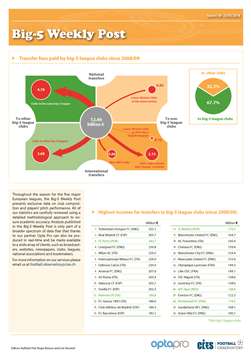
The 68th edition of the Big-5 Weekly Post presents data on the transfer fees paid by big-5 league clubs since 2008/09. In total, 12.5 billion euros were invested in the permanent transfer of first team squad players. Interestingly, more than two thirds of this sum was paid by a big-5 league club to another team in the five major European championships (67.7%).
This fidning demonstrates the existence of a strong big-5 league club internal market. It also shows that the redistribution effect of the transfer system throughout the entire football pyramid is limited.
The club which generated the most income from the transfer of squad members to big-5 league clubs was Tottenham Hotspur (322 million €), closely followed by Spanish giant Real Madrid (304 million). Only five non big-5 league teams are among the 30 clubs that generated the most transfer incomes since 2008/09: Porto (3rd), Palermo (12th), Benfica (16th), Ajax (26th) and Portsmouth (28th). Conversely, many rich teams are ranked in the top 20 positions of the table: Liverpool (4th), Milan (5th), Inter Milan (6th), Arsenal (8th), Roma (9th), Barcelona (15th), Manchester United (17th), Chelsea (19th) and Manchester City (20th).
While the majority of the above-mentioned clubs also spent significant fees to sign new players, our findings show that the current transfer system cannot counter the growing competitive imbalance between clubs at different levels of the league structure. It also suggests that teams with a track record of training new players are not sufficiently rewarded financially as the most lucrative transfers mainly occur between the wealthiest clubs.
Moreover, the growing number of transfers highlighted in the CIES Football Observatory Demographic Study 2014 shows that the current transfer system does not efficiently prevent contract instability. On the contrary, players' mobility is on the increase. This goes hand in hand with the expansion of third-party ownership deals, through which private investors are entitled to shares on future transfer fees. This further undermines the redistribution role of the transfer system throughout the football pyramid.
Our analysis highlights that reform of the current transfer system is needed. An efficient solution would be to redistribute any transfer income to all clubs where a footballer has played during his career according to the total number of matches played for each club. This would ensure a fairer distribution of money to the whole chain of clubs that allowed the player to develop his career before attracting interest from the richest teams. The CIES Football Observatory academic team is at your disposal to undertake simulations for different redistribution scenarios. For more information, please contact us at [email protected].
This website uses cookies – limited to technical and analytical cookies – in order to allow your browsing and enhance your experience.
For more information, please see our cookie policy and our privacy notice.